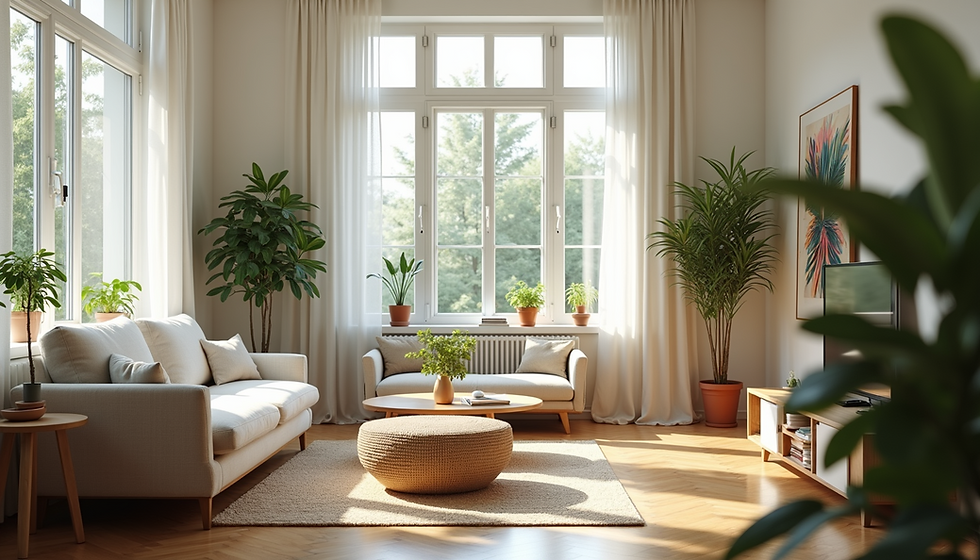Key Elements to Consider for a Beautiful Home
- Param J Singh
- Jun 16
- 3 min read
Creating a beautiful home involves a thoughtful blend of design, functionality, and personal style. Your home is your sanctuary, and it should reflect who you are, serving as both a comfortable living space and a stunning visual statement. Let’s explore key elements to consider when embarking on your home design journey.
Understanding Home Design Principles
Home design is not just about aesthetics; it's about understanding how space works, how light interacts with materials, and how you can create a harmonious environment. A perfect balance of color, texture, and layout can transform an ordinary house into an extraordinary home.
To start, assess your lifestyle. Do you host large gatherings or prefer intimate family dinners? Understanding your needs will help in selecting the right layouts and furniture. Avoid trends that do not resonate with your lifestyle, as these may quickly become outdated.

Choosing the Right Color Palette for Your Home
Color plays a significant role in setting the mood of your home. Warm colors like reds and yellows can create a vibrant and energetic atmosphere, while cool colors like blues and greens tend to be calming and can make a space feel larger.
When selecting a color palette, consider the function of each room. For instance, soft neutrals may be ideal for a bedroom to promote relaxation, while bold hues can energize a home office.
Statistics show that color affects moods and behavior; a study in the Journal of Environmental Psychology indicates that color can even impact productivity in workspaces.
Action Steps:
Pick a main color for each room.
Choose two or three complementary colors to enhance the design.
Test paint samples on your walls before making a decision.

Lighting: The Underrated Hero
Lighting is often an overlooked aspect of home design, yet it significantly influences how a space looks and feels. A well-thought-out lighting plan can highlight architectural features, create ambiance, and improve functionality.
Incorporate three types of lighting:
Ambient lighting, which provides overall illumination.
Task lighting, which aids specific activities like reading or cooking.
Accent lighting, used to highlight artwork or architectural elements.
Natural light should also be maximized. Use sheer window treatments to let in sunlight while maintaining privacy. Position mirrors strategically to reflect light and give the illusion of a larger space.
Action Steps:
Consider your lighting needs and adjust fixtures accordingly.
Use dimmer switches for versatility in ambiance.
Layer your lighting for depth and interest.

Incorporating Nature into Your Design
Biophilic design, which seeks to connect inhabitants with nature, has become increasingly popular in home design. Including natural elements can enhance your well-being and bring life into your home.
Plants, for example, improve air quality and add color and vibrancy. Incorporate greenery with houseplants, garden views, or outdoor spaces. Natural materials like wood and stone can also give your home a warm, organic feel.
Action Steps:
Add houseplants with varying heights and textures to create visual interest.
Use natural materials in furniture or flooring.
Design outdoor spaces that allow for contemplation and relaxation.
Personalizing Your Space
Your home should be a reflection of you and your family. Incorporating personal items, like photographs, artwork, or heirlooms, adds character and warmth. Aim for a mix of textures and styles that come together to tell your story.
Avoid the cookie-cutter approach by selecting unique pieces that resonate with you. This could be a vintage chair from a flea market or an artwork created by a local artist. Personalization makes your home feel unique and inviting.
Action Steps:
Curate a collection of personal items for each room.
Embrace a mix of styles that reflect your personality.
Arrange decor items to create visual focal points.
Bringing It All Together
A beautiful home design is an ongoing process. Consider working with professional home design services to bring your vision to life. They can provide insights and resources that simplify the design process and ensure your space works for you.
Stay flexible and open-minded. Trends will come and go, but your home should evolve with your tastes and needs. Regularly assess your space, and don’t be afraid to make changes that enhance your living experience.
Action Steps:
Periodically evaluate your home to ensure it meets your current needs and tastes.
Stay informed about design trends but prioritize personal style.
Invest in quality over quantity to create a timeless and beautiful space.
Incorporating these key elements will help you create a beautiful home that reflects your individuality and lifestyle. With careful planning, consideration, and a touch of creativity, your dream home is attainable. A thoughtfully designed space not only enhances your daily life but also becomes an extension of who you are. Embrace the journey, and enjoy making your home a beautiful place to live.
.png)



Comments